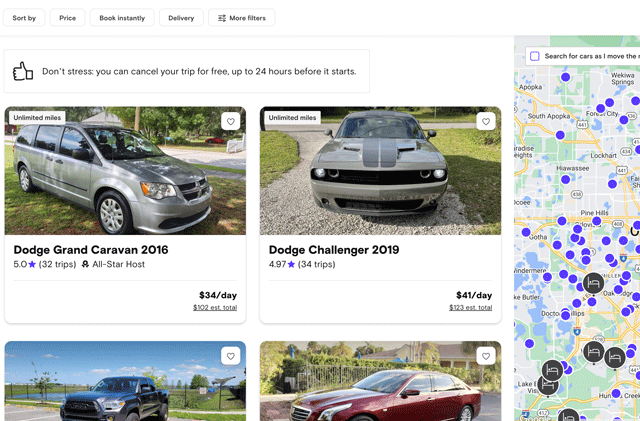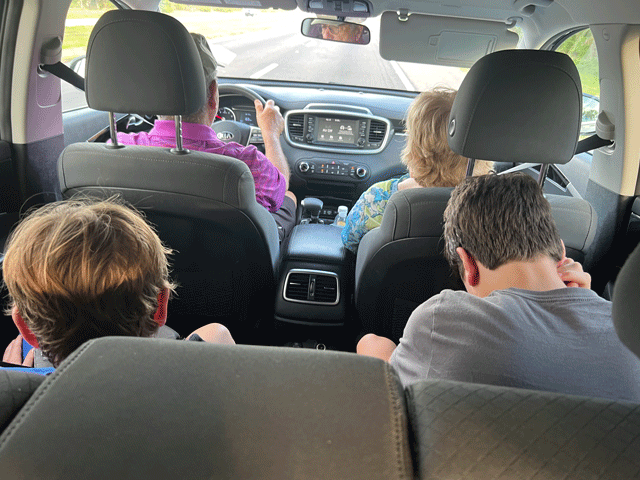Find out how Turo stacks up against traditional rental car companies
If you’re anything like me—with kids who travel about as well as a trio of grumpy cats stuck in a cage together—you’ll do anything to make your journey just a teensy bit easier.
In my 13-year quest for the illusive “easy trip,” I’ve tried it all: I’ve shipped my luggage in advance to avoid the inevitable wait at baggage claim (when my kids are either sprinting wildly through crowds or experimenting with how far onto the luggage conveyer belt they can sit before anyone notices); I’ve used suitcases that double as strollers to keep by wandering toddlers close; I’ve bought a bevy of gadgets to entertain my kids on flights and long car rides.
It’s still hard.
So when I spotted an opportunity to make renting a car a little bit easier, I had to take it.

Turo, a peer-to-peer car rental company founded in 2009, lets you rent a car without the usual rental car tedium: There are no long lines at the airport to endure; no squeezing your whole family into a compact economy car because it’s all that’s left; no worries that you’ll show up at the counter to find out your car was already doled out to someone else. It’s just one car—your choice, down to the make, model, and color—waiting for you when you land.
But what exactly is Turo? How does it work? And is it actually better than a traditional rental car company, especially when you’re traveling with kids? Read on to find out more:
What is Turo?
Basically: Turo works like Airbnb, but for cars. Car owners list their personal cars (though many Turo hosts are seasoned pros who have a fleet of cars on the site), and customers sort through listings to find exactly what they want. The company operates in all 50 states across the US and in 10,000+ cities across the US, UK, Canada, France, and Australia—with rentals at most major airports as well as in pockets of residential areas across the country.
Unlike traditional rental car companies, Turo’s business model lets customers pick the car of their choice—down to the make, model, vehicle year (with options like all-wheel-drive, blind spot monitoring, GPS, child seats, and backup cameras) —and read user reviews to get some assurance on the quality before renting.
“In the last few years, booking with traditional rental car companies has been incredibly difficult due to supply shortages and cancellations,” said Turo Chief Data Officer Albert Mangahas. “It made people realize that they want the power of choice, convenience, and excellent service, especially when traveling with their families.”
Always wanted to drive a Tesla? Curious about what being a Mini Van Mom feels like? Turo is a good way to find out. With more than 1,400 makes and models of cars represented on the site, you can rent the car you’ve always dreamed of (or, at least, the one you think might make for an easy road trip).
“Turo provides guests with the opportunity to make their cars a memorable part of their vacation, whether that’s an SUV, minivan, exotic car, or electric vehicle,” Mangahas said.
As for the quality of the cars, it’s not like anyone can slap their car on the site and wait for the dollars to roll in. Turo requires that all rental vehicles be less than 12 years old (except for “specialty” cars) and must meet Turo’s safety requirements, including providing a record of annual safety inspections (cars registered in these states don’t need to submit a vehicle inspection, according to Turo).

How Does Turo Work?
Finding your car: Type in your destination and the dates you need a car, then select your preferred car type and features (like electric, family-friendly, pet-friendly, etc.) to view a list of available cars. Hosts that have the most experience and best reviews are listed as “All-Star Hosts,” which can give you a good idea of your chosen car’s condition and how easy communication will be with your host.
Adding Extras: Need an infant seat or booster? Snow tires? A ski rack? No problem. Search for cars that offer these extras and your car will be fully loaded when you pick it up.
Provide Your Information: Just like you want to trust your rental car—your rental car’s owner wants to trust you! Consequently, before you can rent a car, you need to give Turo your driver’s license information, photo, credit card information, and home address to verify your identity before you can rent on the site.
Book your trip: All reservations can be canceled up to 24 hours before your trip.

Picking up the car
This is where Turo really differs from traditional rental car companies. Instead of going to an office or building, Turo hosts can deliver the car to the airport, or you can pick it up at another prearranged location. I chose to have the host deliver our car to the airport terminal parking lot, so when we landed in Orlando, Fl., we just walked out of the airport and got our three-row car as if we were Florida natives! (Way easier than waiting 45 minutes at a rental car counter only to be assigned a sedan that would force my three big kids to sit next to each other in the back seat.)
How: Most Turo hosts will park the car with either the doors unlocked and the key in the glove compartment or with a lockbox attached to the underside of the car so that the renter can just get in and go. Some cars also use a remote lock/unlock system so renters can unlock the car from their phone.
Note: Some hosts prefer in-person exchanges—For instance, they’ll pick you up at the airport and drive you to your hotel before giving you the keys. This would be indicated on the host’s listing.
Checking In: When you get to your car, you’ll first need to verify its condition—and prove that you’re actually the one picking up the car (this prevents people from renting cars for others). For instance: I had to take a picture of myself in front of the car with my driver’s license in my hand and upload it to the Turo app.
The check-in process also asks that you upload photos of the interior and exterior of the car (including the mileage and gas indicator, just to show any pre-existing dents or scratches as well as how much gas was in the car when you picked it up).
Note: Since the check-in process relies on the Turo app, keep your cell phone charged! If your toddler has been tapping away at your phone the whole flight and you’re left with zero battery, you won’t be able to log onto the app to find out where your car is or how to get into it.
Returning the car
Similar to the check-in process, returning your car requires that you take it to the designated location (for me, it was the airport’s economy parking lot), upload pictures of the car’s interior and exterior (to show that you left it safe and sound), and leave the keys behind (I was told to leave the keys in the glove compartment and leave the car unlocked). Then… Just walk away!
If there are any incidental charges—like if you didn’t fill up the gas tank before returning it—you’ll be sent an invoice to pay. Additionally, if you left the car unreasonably messy (like, if your toddler vomited all over the seats and you left the crusted remains, or if you drove through a mudslide and your car now looks chocolate-dipped—you’ll be charged a $150 cleaning fee.
To put things into perspective: I didn’t have any problems with returning my 2020 Kia Sorrento, and that’s even with my kids snacking endlessly in the back seat.

Is Turo Cheaper Than Traditional Rental Cars?
At first glance, Turo is vastly cheaper than traditional rental cars—with prices starting at around $29 a day. Costs shoot up if you want a particular make, model, or year, and are dependent on the location, with the average price of a mid-size, mid-value car hovering around $40-70 a day.
When it comes to renting family-friendly cars, Turo also beats out traditional rental car prices. A Turo-listed 2020 Chrysler Pacifica in Los Angeles, for example, starts at $58 a day, while the same car at Enterprise LAX costs $110 a day.
That said, Turo does have some added costs that might make that divide a little smaller. Airport fees (if you want the car delivered to the airport), optional features (like car seats or bike racks), and a Turo “Trip Fee” (which ranges from 2.5% to 100% of the total trip price, with higher value cars having a higher trip fee), may make your Turo rental price not so far away from other rental car companies fees.
NOTE: We recommend buying Turo insurance, which starts at $14 a day. This is because most car insurance companies (or credit card policies if your card offers rental car insurance) don’t recognize Turo as an official rental car agency; consequently, they generally won’t cover you should you get into an accident while driving a Turo car.

The Takeaway:
I spent $331 for a four-day rental in Orlando—much cheaper than if I had rented any three-row car from Budget or Avis. I didn’t have to deal with anyone (except my kids) when I got off the plane. We just walked out of the airport, got in the car, and drove to our hotel. We were out of the airport within 45 minutes of landing!
The only real glitch in the process was that I didn’t get great WiFi at the airport parking lot, so I had a tough time uploading pictures to the app on check-in and return. As for the car, I wasn’t blown away—highway driving was loud, the seats weren’t electric, and I couldn’t get Apple Carplay to work. But I hadn’t specified a luxury car or any specific features, so I wasn’t too perturbed by these things.
The car had three rows, it fit all of us comfortably, and it drove us safely to our destination (for less money). Success.
Pros of Turo:
- Cheaper (generally) than traditional rental car companies
- No need to wait in a rental car line with your kids!
- Huge selection of cars lets you choose a particular model, make, and year
- Plenty of family-friendly cars including SUVs and minivans at competitive prices
- You can select specific family-friendly features such as car seats, bike racks, Apple CarPlay, etc.
- It’s a great way to try out a luxury or specialty car
- You can pick up your car at any time, even if your flight lands late at night (many rental car companies, by contrast, close at a certain time)
Cons of Turo:
- Fees (insurance, trip fee, airport fees, etc.) can add up, making the prices comparable to traditional rental car agencies
- The whole process is dependent on your phone/computer and WiFi signal (if you don’t have a working device, you won’t know where your car is and how to get it—or be able to tell the host where you parked it when you dropped it off)
- You have to rely on user reviews to determine the reliability of your chosen car
- The experience can vary significantly from one trip to another, depending on the owner’s (and previous reviewers’) standards of cleanliness or quality:
- If you cancel less than 24 hours before your trip, you’ll have to pay a portion of the trip fee (whereas some rental car companies don’t charge you at all until you show up at the counter)










